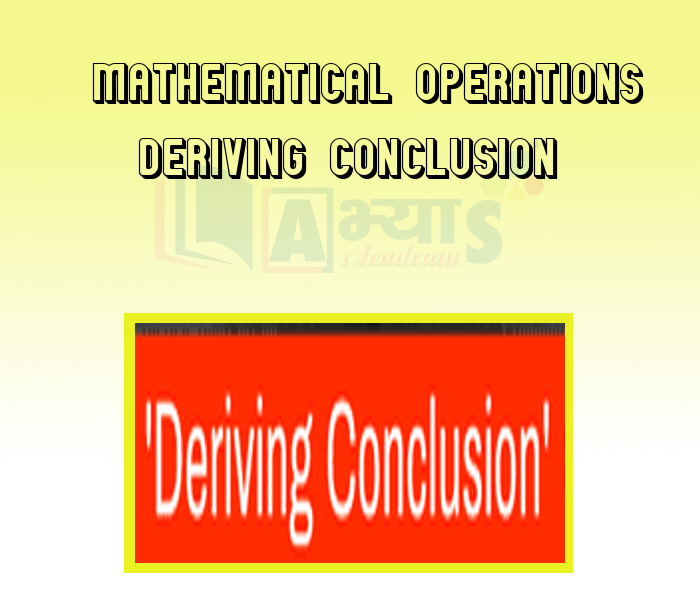Mathematical Operations- Deriving Conclusion





Mathematical Operations- Deriving Conclusion
Mathematical Operations - Deriving Conclusions: In this type of questions, certain relations between different sets of elements is given (in terms of 'less than', 'greater than' or 'equal to'), using either the real symbols or substituted symbols. The candidate is required to analyse the given statements and then decide which of the relations given as alternatives follows from those given in the statements.
Illustration: If A + B > C + D and B + C > A + D, then it is definite that
A. D > B B. C > D C. A > D D. B > D
Answer: D
Solution: Given : A + B > C + D ........... (i) and B + C > A + D ........ (ii)
Adding (i) and (ii), we get :
(A + B) + (B + C) > (C + D) + (A + D)
A + 2B + C > C + 2D + A
2B > 2D
B > D
Hence, the correct option is D.
Illustration: In the following questions, the symbols @, ©, %, and $ are used with the following meanings as illustrated below :
'P @ Q' means 'P is either greater than or equal to Q';
'P © Q' means 'P is either smaller than or equal to Q';
'P % Q' means 'P is greater than Q';
'P Q' means 'P is smaller than Q';
'P $ Q' means 'P is neither greater than nor smaller than Q';
Assuming the given statements to be true, find which of the two conclusions I and II given below them is/are definitely true ?
Statements : D $ M, M % W, W @ R
Conclusions : I. R D II. W © D
A. Only conclusion I is true B.; Only conclusion II is true C. Either conclusion I or II is true; D. Neither I nor II is true
E. Both conclusions I and II are true.
Solution: Clearly, we have :
(i) P @ Q P
Q (ii) P © Q
P
Q
(ii) P % Q P > Q (iv) P
Q
P < Q
(v) P $ Q P
Q and P
Q
P = Q.
Given statements : D = M, M > W, W R.
I. Relation between R and D : R W, W<M, M = D
R
W< M = D
R<D i.e., R
D.
II. Relation between W and D : W < M, M=D ; W<M=D
W<D ; i.e., W
D.
So, only I is true while II is not. Hence, the correct option is A
Which of the following operations will result in 22? | |||
| Right Option : D | |||
| View Explanation | |||
The symbols @, ©, %, 'P @ Q' means 'P is either greater than or equal to Q'; 'P © Q' means 'P is either smaller than or equal to Q'; 'P % Q' means 'P is greater than Q'; 'P 'P $ Q' means 'P is neither greater than nor smaller than Q'; Assuming the given statements to be true, find which of the two conclusions I and II given below them is/are definitely true ? Statements : A © N, N Conclusions : I. J @ N II. A © V
| |||
| Right Option : D | |||
| View Explanation | |||
If being given that If | |||
| Right Option : C | |||
| View Explanation | |||
Students / Parents Reviews [10]
A marvelous experience with Abhyas. I am glad to share that my ward has achieved more than enough at the Ambala ABHYAS centre. Years have passed on and more and more he has gained. May the centre flourish and develop day by day by the grace of God.

Archit Segal
7thAbout Abhyas metholodology the teachers are very nice and hardworking toward students.The Centre Head Mrs Anu Sethi is also a brilliant teacher.Abhyas has taught me how to overcome problems and has always taken my doubts and suppoeted me.

Shreya Shrivastava
8thAbhyas is a complete education Institute. Here extreme care is taken by teacher with the help of regular exam. Extra classes also conducted by the institute, if the student is weak.

Om Umang
10thOne of the best institutes to develope a child interest in studies.Provides SST and English knowledge also unlike other institutes. Teachers are co operative and friendly online tests andPPT develope practical knowledge also.

Aman Kumar Shrivastava
10thMy experience with Abhyas is very good. I have learnt many things here like vedic maths and reasoning also. Teachers here first take our doubts and then there are assignments to verify our weak points.

Shivam Rana
7thMy experience was very good with Abhyas academy. I am studying here from 6th class and I am satisfied by its results in my life. I improved a lot here ahead of school syllabus.

Ayan Ghosh
8thI have spent a wonderful time in Abhyas academy. It has made my reasoning more apt, English more stronger and Maths an interesting subject for me. It has given me a habbit of self studying

Yatharthi Sharma
10thAbhyas Methodology is very good. It is based on according to student and each child manages accordingly to its properly. Methodology has improved the abilities of students to shine them in future.

Manish Kumar
10thIt was good as the experience because as we had come here we had been improved in a such envirnment created here.Extra is taught which is beneficial for future.

Eshan Arora
8thBeing a parent, I saw my daughter improvement in her studies by seeing a good result in all day to day compititive exam TMO, NSO, IEO etc and as well as studies. I have got a fruitful result from my daughter.
